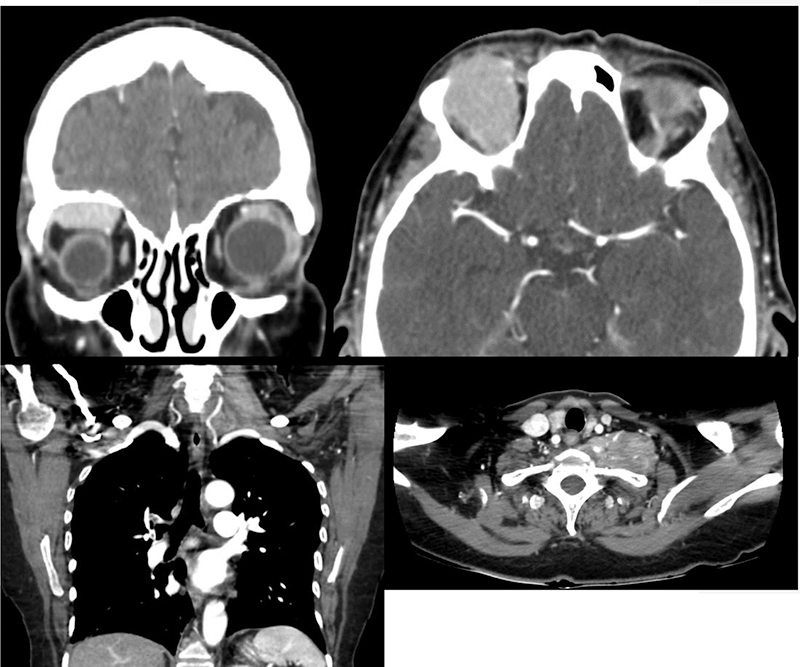

Background: IgG4 related disease is a chronic, immune-mediated, fibro-inflammatory condition that may affect nearly any organ, but most common presentations include salivary glands and lacrimal enlargement, orbital disease, pancreatitis, retroperitoneal fibrosis and tubulointerstitial nephritis. Even as IgG4-related disease is increasingly associated with head and neck manifestations, the involvement of scalene muscles hasn’t been previously described.
Objectives: Describe an interesting case of IgG4 related disease presenting with scalene muscle and ocular manifestations.
Methods: Case report and clinical imaging
Results: 79-year-old female, with a history of Sjogren syndrome treated with hydroxychloroquine 200mg twice a week, presented with unilateral right blepharoptosis. Physical examination confirmed right eye ptosis, supraorbital soft tissue enlargement, diplopia and limited ocular movement. CT Scan revealed right and left orbit with diffuse enlargement of the right superior rectus, suggesting bilateral dacryoadenitis, and most important it described a pseudotumor of 5.7 cm x 3.2 cm x 6.2 cm infiltrating asymmetrically the lower portion of the left scalene muscle. Lacrimal biopsy and immunohistochemistry revealed IgG4 related disease (dense lymphocytic infiltrate, IgG4+:IgG+ ratio 53% and more than 10 cells/hpf). Serum IgG4 concentration 633 mg/dl (more than 5 times upper limit of normal). Pulmonary embolism was also detected. The patients received treatment with a tapering regime of oral prednisone and mycophenolate mofetil for long term immunosuppression, with adequate response and complete remission of symptoms.
Conclusion: The multiorgan involvement and recently recognized nature of IgG4 related disease, may cause confusion among physicians; leading to misdiagnosis, unnecessary procedures and delay in treatment. It requires a high degree of clinical suspicion to diagnose a IgG4 RD, when presenting with ocular involvement, and even more when it affects organs that are not usually associated with this condition, such as scalene muscles. The diagnosis is supported by pathognomonic histopathological findings, and even as treatment strategies are constantly evolving, glucocorticoids remain as first line treatment.
Whether this finding is related with those observed in the paravertebral band – like soft tissue in the thorax, has to be defined. Also interesting is that in this case, this pseudotumor is in the left side.
REFERENCES:
[1]Wallace ZS, et al. The 2019 American College of Rheumatology/European League Against Rheumatism classification criteria for IgG4-related disease. Ann Rheum Dis. 2020.
[2]Maritati F, Peyronel F, Vaglio A. IgG4- related disease: a clinical perspective. Rheumatology. 2020;59(1):iii121-iii131.
[3]Arasit O, Tiraset N, Preechawai P, Kayasut K, Sanghan N. IgG4-related disease in patients with idiopathic orbital inflammation. BMC Ophtalmol 2021;21: 1-9.

Disclosure of Interests: Luis Francisco Valdés Corona Speakers bureau: Sanofi
UCB, Mariana Arroyo: None declared, Francisco Javier Zamarripa Molina: None declared, Angel César Chávez Alanis: None declared